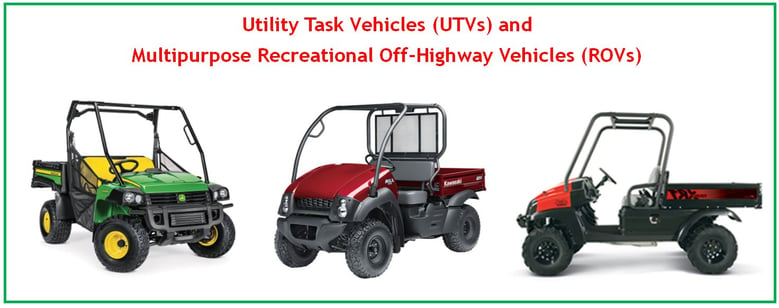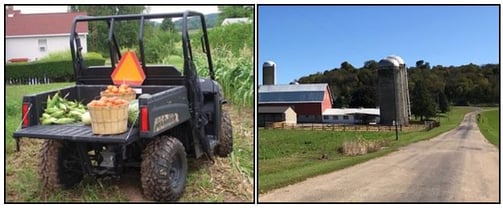Utility Task Vehicles (UTVs) are common on many farm operations with many uses, attachments and benefits. They can go by a variety of names such as side by sides (SxSs) and multipurpose recreational off-highway vehicles (ROVs) and I'm sure many more. Many if not all also double as a recreational vehicle with high performance features. That being said, power and speed are key components of agricultural injuries and fatalities.
What should you know when having employees operating UTVs in "non-recreational" farm tasks?

4 Considerations for UTV Farm Safety
1. Provide Training
Employers are responsible for providing a safe work environment for employees, including a workplace free of recognized hazards. Providing UTV training teaches employees how to operate safely and learn common causes of serious injuries, fatalities and how to avoid them. But don't let it stop there, you need to have regular conversations with employees and communicate your safety and operating expectations when using the UTV. Don't put the employee in a position to guess what your safety expectations are.....they may not match yours.
2. OPerator responsibility
Operators are responsible for their safety and the safety of their passengers. They need to be in control of the UTV and the activities involved. Here is a short list for discussion:
- Speed contributes to accidents - excessive speed requires greater stopping distances and increases the risk of a tip-over on curves. Carrying attachments and pulling loads also requires greater stopping distances and can make the UTV less stable
- Make sure loads are properly secured when hauling cargo, the center of gravity is raised and moves towards the back axle increasing risk of a tip-over
- Never allow people to ride in the cargo box or on the tailgate. Riders can fall off and be injured
- Recognize and avoid hazards and instruct passenger(s) to be aware of correct safety procedures
- Passengers should also be on the look out for hazards and should be prepared for a sudden turn, emergency breaking or an unexpected bump
- Never allow more people to ride than the UTV is equipped for (1 seatbelt per passenger)
- To ride safely, passengers must be able to grasp the hand holds while wearing a seatbelt and both feet flat on the floor. Do not allow undersized individuals to ride in the passenger seat.
3. Rollover Protective Structures (ROPS)
 UTVs that travel less than 25 mph may not be required to have ROPS but some do. ROVs that travel in excess of 30 mph are required to have ROPS and a harness system or seatbelt to keep people inside the protective structure. ROPS are designed to keep you safe, however only with the use of a seatbelt. Manufacturers and operators manuals require seatbelts be worn at all times. However, injury reports and surveys indicate that people in general don't wear seatbelts. If you do not require employees to wear seatbelts 100% of the time, you may want to set speed parameters that are specific to different tasks within your operation. Communicate them clearly and with regularity.
UTVs that travel less than 25 mph may not be required to have ROPS but some do. ROVs that travel in excess of 30 mph are required to have ROPS and a harness system or seatbelt to keep people inside the protective structure. ROPS are designed to keep you safe, however only with the use of a seatbelt. Manufacturers and operators manuals require seatbelts be worn at all times. However, injury reports and surveys indicate that people in general don't wear seatbelts. If you do not require employees to wear seatbelts 100% of the time, you may want to set speed parameters that are specific to different tasks within your operation. Communicate them clearly and with regularity.
Understand that when seatbelts or harnesses are not worn in a rollover situation, injuries are "significant". Head, ribs, arms and legs are no match for a tumbling 500-1000 lb., UTV. People commonly die from asphyxiation after being pinned under the UTV. Not only may they have the wind knocked out of them, they have little leverage to work their arms and legs to get free....especially while injured.
4. Roadway use
Manufacturers clearly state UTVs are not designed for roadway use. UTVs have a high center of gravity and a narrow track. The tires are not made for roadway surfaces and most have a solid rear axle or fixed rear differential. These 4 characteristics make them ideal for off-road and dangerous on paved and unpaved roadways. Consider alternatives to keep employees from traveling down paved and unpaved roads. Implement speed and seatbelt guidelines when this is unavoidable. Install a SMV sign and be sure to have properly working lights. 
Check your state, city and county laws for operating a UTV on roadways. A general rule of thumb is only allow operators at least 16 years old and with a valid drivers license. Check with your insurance provider. You don't want to operate outside the bounds of your policy and you may want to inquire about employees with DUIs.
The injury and fatality statistics cannot be ignored! Most UTV fatalities (est. 80%) "on roadways" are from a collision with an object or a rollover. Meaning they for some reason lost control. Two common denominators in fatalities on roadways are speed and not wearing a seatbelt. Victims are often ejected, struck by an object or pinned.
Surveys taken from the Farm Progress Show revealed how truly popular UTVs were on farm operations and how often they were driven on roadways. 15% reported having a lifetime crash, in 38% of the crashes the person was injured and 1/3 sought medical attention. Think about your operation's high risk activities and think about your own crashes/near misses. Plan to mitigate risks of UTV incidents.
Final Thoughts
The occupational functionality of using UTVs along with the recreational use have made UTV’s very common on farms and ranches. So it stands to reason that there will be injuries and fatalities. This blog is intended to address the work environment in keeping employees safe and not the recreational aspect of operating a UTV. In order to keep your employees safe while operating a UTV, I suggest the ATV Safety training by Good Day's Work and communicate your safety expectations clearly to your employees.
UTVs are not to become a recreational vehicle for employees at any time. This is to reduce the likelihood of an injury. Not only could you lose the service of a valuable employee, the direct and indirect costs associated with the accident/injury are staggering. Review your insurance coverage for UTV use and confirm it's up to date. By having safety standards and expectations for employees, you reduce the likelihood of a UTV accident.
As always, safety is about more than being OSHA compliant. It’s about keeping your most valuable asset (your team) safe and healthy. At Good Day's Work, we partner with you to create a true safety culture. Let’s make sure everyone gets home safe after a good day's work.
* Some information was pulled from a presentation given by Dr. Charles A. Jennissen, MD.


